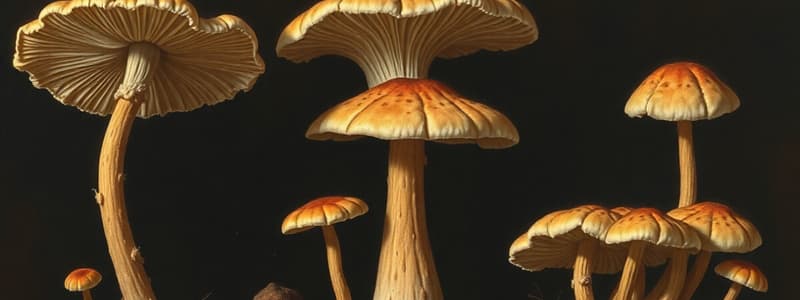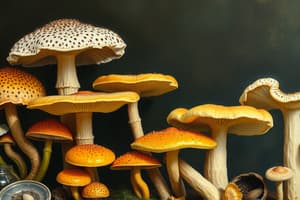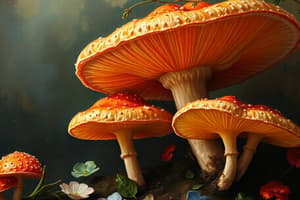Podcast
Questions and Answers
Quel est le traitement utilisé contre les tænias chez l'humain?
Quel est le traitement utilisé contre les tænias chez l'humain?
- Metronidazole
- Albendazole
- Praziquantel
- Niclosamide (correct)
Les oxyures se transmettent par contact direct avec une personne infectée.
Les oxyures se transmettent par contact direct avec une personne infectée.
False (B)
Quel vers est responsable de l'ascaridiose?
Quel vers est responsable de l'ascaridiose?
Ascaris
Les helminthes sont aussi connus sous le nom de ______.
Les helminthes sont aussi connus sous le nom de ______.
Associez chaque type d'helminthes avec leur classification:
Associez chaque type d'helminthes avec leur classification:
Quels symptômes peuvent être associés à une infection par tænias?
Quels symptômes peuvent être associés à une infection par tænias?
Quel type de champignon est généralement inoffensif mais peut devenir pathogène dans certaines circonstances?
Quel type de champignon est généralement inoffensif mais peut devenir pathogène dans certaines circonstances?
Les dermatophytes sont des champignons opportunistes.
Les dermatophytes sont des champignons opportunistes.
Nommez une mycose cutanée causée par des champignons pathogènes.
Nommez une mycose cutanée causée par des champignons pathogènes.
Le champignon du genre ________ peut provoquer une candidose.
Le champignon du genre ________ peut provoquer une candidose.
Associez les types de mycoses aux exemples qui leur correspondent :
Associez les types de mycoses aux exemples qui leur correspondent :
Quel exemple ne fait pas partie des mycoses superficielles?
Quel exemple ne fait pas partie des mycoses superficielles?
L'aspergillose est causée par des champignons pathogènes exclusivement.
L'aspergillose est causée par des champignons pathogènes exclusivement.
Quel champignon est lié à des infections pulmonaires dans le cas de l’aspergillose?
Quel champignon est lié à des infections pulmonaires dans le cas de l’aspergillose?
Les ________ sont des maladies causées par des champignons microscopiques.
Les ________ sont des maladies causées par des champignons microscopiques.
Quel est un facteur prédisposant à la candidose orale chez les bébés?
Quel est un facteur prédisposant à la candidose orale chez les bébés?
Les lactobacilles vaginaux empêchent la croissance des champignons en maintenant un pH élevé.
Les lactobacilles vaginaux empêchent la croissance des champignons en maintenant un pH élevé.
Quel est le vecteur de la maladie du sommeil?
Quel est le vecteur de la maladie du sommeil?
La candidose vaginale peut être une complication du ______.
La candidose vaginale peut être une complication du ______.
Associez les protozoaires avec leur maladie respective :
Associez les protozoaires avec leur maladie respective :
Quel est le vecteur du paludisme?
Quel est le vecteur du paludisme?
La majorité des personnes infectées par Toxoplasma gondii présentent des symptômes.
La majorité des personnes infectées par Toxoplasma gondii présentent des symptômes.
Quel pourcentage de la population mondiale est infecté par Toxoplasma gondii?
Quel pourcentage de la population mondiale est infecté par Toxoplasma gondii?
La candidose intertrigo se manifeste dans les plis de la peau et est souvent observée dans les zones des ______.
La candidose intertrigo se manifeste dans les plis de la peau et est souvent observée dans les zones des ______.
Quelle est la principale source de transmission des protozoaires chez l'homme?
Quelle est la principale source de transmission des protozoaires chez l'homme?
Quel est le type de vers responsable de l'ascaridiose?
Quel est le type de vers responsable de l'ascaridiose?
Les oxyures se transmettent par l'eau contaminée.
Les oxyures se transmettent par l'eau contaminée.
Quel traitement est utilisé pour les infections par tænias?
Quel traitement est utilisé pour les infections par tænias?
Les ______ sont des parasites de l'intestin humain transmis par la viande.
Les ______ sont des parasites de l'intestin humain transmis par la viande.
Associez chaque type d'helminthes avec leur définition:
Associez chaque type d'helminthes avec leur définition:
Quel symptôme est associé à une infection par tænias?
Quel symptôme est associé à une infection par tænias?
Les œufs d'oxyures restent viables pendant plusieurs jours dans l'environnement.
Les œufs d'oxyures restent viables pendant plusieurs jours dans l'environnement.
Comment se fait la contamination par Ascaris?
Comment se fait la contamination par Ascaris?
Les oxyures causent une maladie appelée ______.
Les oxyures causent une maladie appelée ______.
Associez chaque helminthes à son type d'infection:
Associez chaque helminthes à son type d'infection:
Quel type de champignon est un exemple de champignon pathogène?
Quel type de champignon est un exemple de champignon pathogène?
La candidose est une maladie causée par des champignons opportunistes.
La candidose est une maladie causée par des champignons opportunistes.
Quel est un facteur prédisposant à la candidose orale chez les bébés?
Quel est un facteur prédisposant à la candidose orale chez les bébés?
Nommez une mycose cutanée causée par un champignon pathogène.
Nommez une mycose cutanée causée par un champignon pathogène.
Les _____ sont des microorganismes eucaryotes qui peuvent être unicellulaires ou pluricellulaires.
Les _____ sont des microorganismes eucaryotes qui peuvent être unicellulaires ou pluricellulaires.
La candidose vaginale est exclusivement causée par des infections à Candida.
La candidose vaginale est exclusivement causée par des infections à Candida.
Associez les champignons avec leurs maladies respectives :
Associez les champignons avec leurs maladies respectives :
Quelle maladie est transmise par le vecteur mouche Tsétsé?
Quelle maladie est transmise par le vecteur mouche Tsétsé?
Les ____ sont des unicellulaires eucaryotes transmis par des arthropodes.
Les ____ sont des unicellulaires eucaryotes transmis par des arthropodes.
Quel champignon est généralement présent dans le microbiote humain?
Quel champignon est généralement présent dans le microbiote humain?
Associez les protozoaires avec leur vecteur :
Associez les protozoaires avec leur vecteur :
Tous les champignons sont pathogènes.
Tous les champignons sont pathogènes.
Quel pourcentage de la population mondiale est infecté par Toxoplasma gondii?
Quel pourcentage de la population mondiale est infecté par Toxoplasma gondii?
Quelle est une caractéristique clé des champignons opportunistes?
Quelle est une caractéristique clé des champignons opportunistes?
Les mycoses superficielles incluent des maladies telles que la _____.
Les mycoses superficielles incluent des maladies telles que la _____.
L'intertrigo à Candida se manifeste uniquement dans les plis de la peau.
L'intertrigo à Candida se manifeste uniquement dans les plis de la peau.
Quel est le vecteur responsable de la transmission du paludisme?
Quel est le vecteur responsable de la transmission du paludisme?
Quel champignon est responsable des infections pulmonaires dans le cas de l'aspergillose?
Quel champignon est responsable des infections pulmonaires dans le cas de l'aspergillose?
La candidose intertrigo est souvent observée dans les plis de la peau et dans les zones des ____.
La candidose intertrigo est souvent observée dans les plis de la peau et dans les zones des ____.
Quelle condition peut limiter la croissance des champignons dans le vagin?
Quelle condition peut limiter la croissance des champignons dans le vagin?
Flashcards
Champignons
Champignons
Micro-organismes eucaryotes, unicellulaires ou pluricellulaires
Mycoses
Mycoses
Diseases caused by microscopic fungi.
Champignons pathogènes
Champignons pathogènes
Fungi that cause disease.
Champignons opportunistes
Champignons opportunistes
Signup and view all the flashcards
Dermatophytes
Dermatophytes
Signup and view all the flashcards
Teigne
Teigne
Signup and view all the flashcards
Pied d’athlète
Pied d’athlète
Signup and view all the flashcards
Onychomycose
Onychomycose
Signup and view all the flashcards
Aspergillose
Aspergillose
Signup and view all the flashcards
Candidose
Candidose
Signup and view all the flashcards
Candida albicans
Candida albicans
Signup and view all the flashcards
Protozoaires
Protozoaires
Signup and view all the flashcards
Maladie du sommeil
Maladie du sommeil
Signup and view all the flashcards
Malaria
Malaria
Signup and view all the flashcards
Toxoplasmose
Toxoplasmose
Signup and view all the flashcards
Helminthes
Helminthes
Signup and view all the flashcards
Plathelminthes
Plathelminthes
Signup and view all the flashcards
Némathelminthes
Némathelminthes
Signup and view all the flashcards
Tænias
Tænias
Signup and view all the flashcards
Ascaridiose
Ascaridiose
Signup and view all the flashcards
Oxyurose
Oxyurose
Signup and view all the flashcards
Fungal Infections
Fungal Infections
Signup and view all the flashcards
Opportunistic Fungi
Opportunistic Fungi
Signup and view all the flashcards
Candida Infections
Candida Infections
Signup and view all the flashcards
Mycoses
Mycoses
Signup and view all the flashcards
Dermatophytes
Dermatophytes
Signup and view all the flashcards
Aspergillosis
Aspergillosis
Signup and view all the flashcards
Candida albicans
Candida albicans
Signup and view all the flashcards
Pathogenic Fungi
Pathogenic Fungi
Signup and view all the flashcards
Superficial Fungal Infections
Superficial Fungal Infections
Signup and view all the flashcards
Immune System Weakening
Immune System Weakening
Signup and view all the flashcards
Candida Infection (Vaginal)
Candida Infection (Vaginal)
Signup and view all the flashcards
Oral Thrush (Candida)
Oral Thrush (Candida)
Signup and view all the flashcards
Intertrigo (Candida)
Intertrigo (Candida)
Signup and view all the flashcards
Sleeping Sickness
Sleeping Sickness
Signup and view all the flashcards
Malaria
Malaria
Signup and view all the flashcards
Toxoplasmosis
Toxoplasmosis
Signup and view all the flashcards
Protozoan Transmission
Protozoan Transmission
Signup and view all the flashcards
Protozoa
Protozoa
Signup and view all the flashcards
Candida
Candida
Signup and view all the flashcards
Yeast Infection
Yeast Infection
Signup and view all the flashcards
Helminthes
Helminthes
Signup and view all the flashcards
Tapeworms
Tapeworms
Signup and view all the flashcards
Ascaridiose
Ascaridiose
Signup and view all the flashcards
Oxyurose
Oxyurose
Signup and view all the flashcards
Plathelminthes
Plathelminthes
Signup and view all the flashcards
Némathelminthes
Némathelminthes
Signup and view all the flashcards
Contaminated food
Contaminated food
Signup and view all the flashcards
Symptoms of helminth infection
Symptoms of helminth infection
Signup and view all the flashcards
Transmission of helminths
Transmission of helminths
Signup and view all the flashcards
Treatment for helminth infections
Treatment for helminth infections
Signup and view all the flashcards
Study Notes
Les Champignons
- Les champignons sont des micro-organismes eucaryotes unicellulaires ou pluricellulaires.
- Les mycoses sont des maladies engendrées par des champignons microscopiques.
- Deux grandes classes de champignons:
- Champignons pathogènes
- Champignons opportunistes
Champignons pathogènes
- Exemple: les dermatophytes.
- Les dermatophytes causent :
- Mycoses superficielles du cuir chevelu (ex : teigne)
- Mycoses cutanées (Ex: pied d’athlète)
- Onychomycose : dermatophytose des ongles
Champignons opportunistes
- Les champignons opportunistes sont généralement inoffensifs mais peuvent devenir pathogènes dans certaines circonstances.
- Exemples :
- Aspergillose: présente dans l'air, peut causer une aspergillose pulmonaire.
- Candidose: causée par des champignons du genre Candida (C.Albicans).
Candidose
- Le Candida albicans est présent dans le microbiote de l’appareil digestif, respiratoire, vaginal et buccal.
- Chez les individus sains: pas de maladie.
- Si l’immunocompétence est perturbée: les champignons se multiplient rapidement et provoquent une candidose.
- Transmissible par voie sexuelle.
- Les candidoses peuvent se manifester sous différentes formes:
- Candidose orale ou muguet buccal:
- Bébé: pas de microbiote normal dans la région oropharyngée
- Inhalation de stéroïdes
- Affaiblissement du système immunitaire = facteur prédisposant à la candidose.
- Intertrigo à Candida:
- aisselles, l’aine, les plis de la peau
- intertrigo périanal chez le bébé
- Vaginite à Candida:
- complication du diabète
- d’une antibiothérapie
- contraceptifs oraux
- Normalement: lactobacilles vaginaux limitent la croissance des champignons en maintenant un pH bas.
- Candidose orale ou muguet buccal:
Les Protozoaires
- Les protozoaires/protistes sont des organismes unicellulaires eucaryotes.
- Transmission chez l'homme par:
- Des arthropodes (vecteurs)
- La nourriture
- De l’eau contaminée
- Contact direct
Trypanosomes et la maladie du sommeil
- Vecteur = mouche Tsétsé.
- Transmission à l’hôte (infection mortelle).
- 65 000 personnes meurent / an de la maladie du sommeil.
Plasmodium et la malaria (paludisme)
- Vecteur : anophèle
- Symptômes:
- Fièvre
- 600 000 morts/an
Toxoplasma gondii et la toxoplasmose
- Maladie mondiale causée par Toxoplasma gondii.
- 90% de la population mondiale > 12 ans sont infectés.
- La majorité des personnes infectées ne présentent pas de symptômes (système immunitaire prévient généralement la maladie).
- Véhicule = chats !
- Le protiste peut infecter le fœtus (malformations congénitales graves ou mort).
Les helminthes
- Vers parasites (intestinaux) de l’homme et des animaux.
- Deux types :
- Plathelminthes:
- Trématodes (douves)
- Cestodes (tænias)
- Némathelminthes:
- Ascaris
- Oxyures
- Plathelminthes:
Tænias ou vers solitaires:
- Parasites de l’intestin humain transmis par la viande.
- Symptômes: douleurs abdominales, nausées, troubles du transit.
- Traitement: Niclosamide (anthelminthique).
Ascaris et l’ascaridiose
- Infection fréquente dans les pays tropicaux à hygiène insuffisante.
- Contamination par nourriture contaminée ou eau souillée.
Oxyures et l’oxyurose
- Ver rond responsable de l'oxyurose.
- La contamination se fait par l'ingestion des œufs émis dans le milieu extérieur.
- Les œufs restent viables plusieurs jours dans les vêtements, les draps, sur les objets et sur le sol.
- Un sujet sain s'infecte facilement en portant les mains ou un objet souillé à la bouche.
Studying That Suits You
Use AI to generate personalized quizzes and flashcards to suit your learning preferences.




